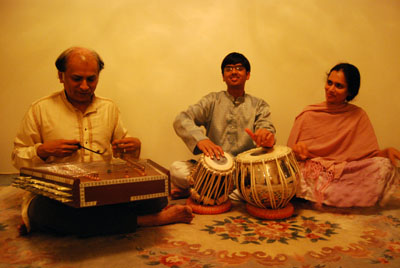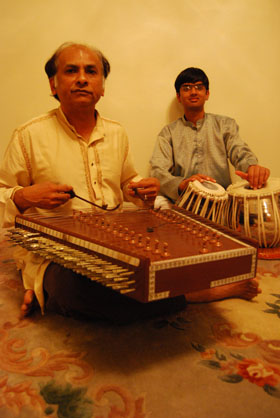 Editor’s Note: Master artist Arshad Syed and apprentice Vikas Yendluri are current participants in the Alliance’s Apprenticeship Program, conducting an apprenticeship in North Indian Hindustani tabla music. In the following article, Yendluri discusses North Indian Hindustani tabla music and his experiences as Syed’s apprentice.
Editor’s Note: Master artist Arshad Syed and apprentice Vikas Yendluri are current participants in the Alliance’s Apprenticeship Program, conducting an apprenticeship in North Indian Hindustani tabla music. In the following article, Yendluri discusses North Indian Hindustani tabla music and his experiences as Syed’s apprentice.
I enter a room, hands together as if about to pray, and say Namaste to Arshadji. The salutation literally means, “I bow down to you,” a form of respect to a master who humbly sits cross-legged on the ground, eager to teach. But the greeting is not just towards my teacher, but also to an instrument and the tradition that accompanies it.
Twice a week, I visit the residence of my guru, Arshad Syed, for tabla lessons. Arshadji, as his students respectfully call him, is one of the foremost exponents of the tabla worldwide. Amongst his accomplished works are recordings with the Diga Rhythm Band, Grateful Dead drummer Mickey Hart, the Rhythm Experience with Zakir Hussain, as well as fusion works with bands like Ancient Future and Flamenco guitarists in Spain. Yet Arshadji dedicates a lot of his time to teaching, guiding over a hundred students since 1974. As he says, “It is very fulfilling to be a performer, but it is even more fulfilling to produce students who can perform, and the ultimate reward is if you can produce a student who can carry on the tradition.” I began lessons with Arshadji when I was five, and have continued for twelve years since. Surrounded by family members who have also learned tabla from Arshadji, trained in traditional Indian dance, and promoted concerts for Indian classical music, I have been motivated since a young age to pursue music. Beyond all the work expected of a high school student, I spend every free moment I can grab practicing an art form that requires years of dedication to become a novice, decades to become proficient, and a lifetime to become a professional.
As North Indian Classical Music is based on Indian rhythms, the tabla epitomizes these rhythms. The tabla is the main percussion instrument of India, mostly used in the accompaniment of other Indian music. But it is also a full-fledged solo instrument. The instrument is known for its complexity of rhythms—rhythms that are mathematically designed, and employ many divisions of a given time cycle that are ever changing. When accompanying, the tabla player lays the base rhythm for another instrumentalist or vocalist to lay their own improvisation on. While North Indian classical music is 2000 years old, the tabla is a 400 year old instrument that evolved from other Indian drums like the Pakhawaj. In this time there has spread a strong lineage of tabla players in India, as one tabla player becomes a Guru (teacher) for many other aspiring students. For instance, Arshadji learned from one of the greatest tabla players of the last century, Ustad Allah Rakha, the Khalifa (Grand Master) of the Punjab Gharana (school/tradition) of tabla playing. The Punjab Gharana is one of the oldest schools of tabla playing; thus, Arshadji passes down hundreds of years of tradition through his teaching. Despite growing up in the USA, I feel that playing tabla has taught me a lot about Indian culture: respect for elders, learning about Indian languages, wearing Indian clothes when playing in a concert, and most importantly, a religious connection to Hinduism due to the fact that the lyrics of most North Indian classical music serves as a form of prayer to Hindu gods.
 Through this apprenticeship, I’ve worked on perfecting the techniques and compositions of tabla. Developing each of these techniques for the different aspects of drumming requires a great amount of time spent with Arshadji, learning in the traditional manner by mimicking his style, observing his ideas on drumming, and imitating the sounds he produces and the positions of his fingers. Minor changes in positioning can transmute weak sounds into powerful syllables. Gaining the stamina required for three hour concerts necessitates good technique so that one does not waste energy playing tabla inefficiently. Thankfully, Arshadji is not only a master of the tabla, but also of the pakhawaj, the instrument that the tabla is derived from (legend goes that an angry pakhawaj player broke his drum into two pieces to create the first tabla). The Punjab gharana of tabla playing is characterized by its similarity to pakhawaj playing, and by studying both instruments very carefully, Arshadji is able to convey the finer points of this gharana’s techniques easily to his students. Technique is an aspect of the instrument that tabla players work on their whole life. But it is crucial for students to work on technique during their younger years, when their hands are supple and can be molded into tabla-player-hands. The battle to gain good technique is distressing at first; it takes at least a year before a beginner can play the most basic syllable of the tabla, called “na.” As a beginner, Arshadji helped me practice technique by teaching me how to play simple phrases. But soon after, he taught me how to string these phrases together into complete, wholesome compositions. Nowadays, Arshadji mostly teaches me kaidas, which are mathematically intense tabla compositions; relas, which are compositions that emphasize speed and sound over mathematics; and bols, which are shorter compositions that are recited, then played. All tabla compositions are passed down from teacher to student orally, for writing cannot adequately convey the accents, feelings, and moods that accompany each composition. While teaching me these compositions, Arshadji also teaches me how to play in the different taals, rhythmic cycles that are an integral part of North Indian Classical Music. There are at least 360 different Indian taals known today, and understanding each one requires an immense amount of study.
Through this apprenticeship, I’ve worked on perfecting the techniques and compositions of tabla. Developing each of these techniques for the different aspects of drumming requires a great amount of time spent with Arshadji, learning in the traditional manner by mimicking his style, observing his ideas on drumming, and imitating the sounds he produces and the positions of his fingers. Minor changes in positioning can transmute weak sounds into powerful syllables. Gaining the stamina required for three hour concerts necessitates good technique so that one does not waste energy playing tabla inefficiently. Thankfully, Arshadji is not only a master of the tabla, but also of the pakhawaj, the instrument that the tabla is derived from (legend goes that an angry pakhawaj player broke his drum into two pieces to create the first tabla). The Punjab gharana of tabla playing is characterized by its similarity to pakhawaj playing, and by studying both instruments very carefully, Arshadji is able to convey the finer points of this gharana’s techniques easily to his students. Technique is an aspect of the instrument that tabla players work on their whole life. But it is crucial for students to work on technique during their younger years, when their hands are supple and can be molded into tabla-player-hands. The battle to gain good technique is distressing at first; it takes at least a year before a beginner can play the most basic syllable of the tabla, called “na.” As a beginner, Arshadji helped me practice technique by teaching me how to play simple phrases. But soon after, he taught me how to string these phrases together into complete, wholesome compositions. Nowadays, Arshadji mostly teaches me kaidas, which are mathematically intense tabla compositions; relas, which are compositions that emphasize speed and sound over mathematics; and bols, which are shorter compositions that are recited, then played. All tabla compositions are passed down from teacher to student orally, for writing cannot adequately convey the accents, feelings, and moods that accompany each composition. While teaching me these compositions, Arshadji also teaches me how to play in the different taals, rhythmic cycles that are an integral part of North Indian Classical Music. There are at least 360 different Indian taals known today, and understanding each one requires an immense amount of study.
While I have been learning mostly solo tabla for the past twelve years, this apprenticeship has also helped me develop the skills necessary for accompaniment of other musicians. True accompaniment requires an understanding of all Indian music, be it classical instrumental, classical vocal, light instrumental, light vocal, thumri, ghazal, bhajans, and even the pop and film songs of India. Arshadji has an intimate understanding of Indian melody; his amazing mastery of the tabla and pakhawaj is supplemented by his innovative, original approach to the santoor, a hundred-stringed lute played with wooden mallets. He learned santoor from Pandit Shivkumar Sharma, the father of the modern instrument. Usually, tabla players are left to learn accompaniment by themselves due to inadequate teaching. But because Arshadji plays both tabla and santoor, he is able to teach me the skills of accompaniment from both perspectives. The most important skill necessary for accompaniment is improvisation, because traditionally, a tabla player will not know what he or she is about to accompany until the concert begins. Arshadji and I work on improvisation during one of our two classes every week. Class begins as Arshadji begins to play a raag on the santoor, but he won’t tell me what he’s playing beforehand to mimic real life accompaniment situations. I have to figure out when to join in with him, match what he is playing as he improvises, and take multiple, spontaneous drum solos in between. After a successful (or failed) attempt at each, we stop and go over what I did fine and what I could have done better. Then we retry, and move on.
Our training process resembles the training process that has been used to pass down tabla for the past four hundred years. Arshadji has carried me along the whole way, first allowing me to small tabla solos in student recitals and competitions, then accompany him in public concerts. The apprenticeship sponsored by the Alliance for California Traditional Arts represents the next step in the training process. As I conclude each class by saying Namaste, I direct the homage not only at Arshadji, an instrument, and a tradition, but also to the circumstances, people, and organizations that help me develop my skills in tabla everyday.
